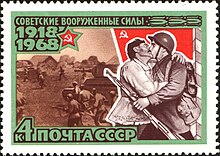Socialist brother kiss

The socialist brotherly kiss or communist brotherly kiss was a greeting ritual of individual and small groups of communists, who indicated their solidarity through the kiss in order to signal that they belonged to the group of communists. At the time of Stalinism, the brotherly kiss increasingly lost its meaning and developed into an official diplomatic ritual, a special form of respect between statesmen of the so-called Eastern Bloc .
Development from custom to ceremonial
The brotherly kiss has its roots in the guild tradition . With hugs and kisses, during the labor movement emerging from the middle to the end of the 19th century, workers exuberantly expressed their enthusiasm for solidarity over membership of the working class . In the years after the October Revolution and the emerging Communist International , the initially spontaneous gesture of the brotherly kiss was ritualized into an official act of greeting among communist and socialist comrades who had made the arduous journey to Russia , which was then isolated at the time , in order to show international solidarity express and affirm.
According to the German social and media scientist Dmitri Zakharine , one can see from the newsreels and daily news stories how the representatives of power in the Eastern Bloc have increasingly practiced an initiation rite of fraternization since the 1950s, in which the brotherly kiss shows a development from custom to ceremonial . In the beginning, the brotherly kiss was still practiced without an elaborated, binding communicative scheme of action and the gestures accompanying the rite would have seemed rustic in order to give the audience the impression of spontaneous open-heartedness. It was not until the 1960s that a mutually expected communicative fraternal kiss developed and finally stabilized during visits by Soviet representatives to the Eastern European countries. In the late 1980s, the main focus shifted from kissing to the entire ceremonial process, especially to the approaching participants in the ritual.
Communicative scheme
In the course of the 1960s, when Soviet heads of state visited Eastern Bloc countries, a fixed communicative fraternal kiss was established, in which the fraternal kiss was indicated when leaving the aircraft, usually by spreading hands. This was followed by a symmetrical approach between two men for a hug, which was usually followed by a three-time cheek kiss. During Leonid Ilyich Brezhnev's tenure , the brother kiss was still practiced directly on the plane. Only the East German party leaders crowned the brotherly kiss on the cheeks with a deep kiss on the mouth through close lip contact. The brotherly kiss meant more than shaking hands with other statesmen and was intended to demonstrate the special bond between the socialist states. Hugs and kisses should be expressions of joy, brotherhood and equality.
symbolism
According to Dmitri Zakharine , the symbolism of the communist brotherly kiss is shaped by a hidden semantics of premodern family-like community formations, in which the symbolism played a central role in the acceptance into the family. The imaginative worlds of traditional peasant cultures in Russia and the Ukraine would have shaped their actions, regardless of the atheistic communist training of the party leaders. Claudia Schimmel put forward the thesis that the socialist brotherly kiss had been integrated into their diplomatic welcoming ritual by the communists in the Eastern bloc of the time, via the tradition of the religious symbol of the Orthodox Easter kiss of the Russian Orthodox Church as a community-building political symbol.
art
The brotherly kiss became famous through the photographer Régis Bossu , who photographed Erich Honecker (GDR) and Leonid Brezhnev (Soviet Union) in October 1979 after a speech on the occasion of the 30th anniversary of the GDR . On the basis of this picture, the famous brother kiss painting at the East Side Gallery was created later .
Web links
- Article "The 'socialist brotherly kiss'" by Claudia Schimmel (PDF, 128 kB)
Individual evidence
- ↑ Claudia Schimmel: “The 'socialist brother kiss'” p. 81.
- ↑ Dmitri Zakharine: Face to Face. The change in direct communication in the western and eastern European modern times. UVK Verlag, Konstanz 2005. p. 533.
- ↑ Dmitri Zakharine: Face to Face. The change in direct communication in the western and eastern European modern times. UVK Verlag , Konstanz 2005. p. 533.
- ↑ Claudia Schimmel: “The 'socialist brother kiss'” p. 81f.
- ↑ Dmitri Zakharine : Face to Face. The change in direct communication in the western and eastern European modern times. UVK Verlag, Konstanz 2005. p. 538.
- ↑ Claudia Schimmel: “The 'socialist brother kiss'” p. 81.
- ↑ Augsburger Allgemeine v. July 6, 2010 on the occasion of World Kiss Day
- ↑ Carolin Pirich: A picture of a picture. In: FAZ.net . August 13, 2009, accessed October 13, 2018 .

